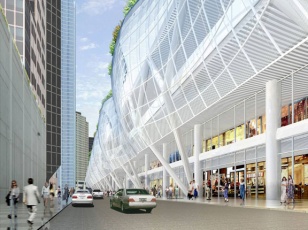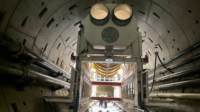The Transbay Transit Center project in San Francisco reached another important milestone as the Transbay Joint Powers Authority recently closed on the $171 million Transportation Infrastructure Finance and Innovation Act (TIFIA) loan for the project.

The loan was made possible based on the TJPA�s sound finance plans, favorable audits and positive credit reviews�requiring an investment grade credit rating, the authority says. The loan will fund 14% of the project�s $1.2 billion Phase I capital costs to build the new Transbay Transit Center project on Mission and First streets. The project is funded through local, state, and federal funding sources.
�This is a very important milestone that brings our collective vision of the Transbay Transit Center one step closer to reality,� says San Francisco Mayor Gavin Newsom. �With this funding today and positive news later this winter on our stimulus money request, we can begin actual construction on this critical project and begin creating thousands of jobs.�
�We are thrilled to be one of the first modern rail stations in the United States to achieve this historic milestone and look forward to continuing to make progress on the Transbay project,� says Maria Ayerdi-Kaplan, executive director of the Transbay Joint Powers Authority. �We are grateful for the strong leadership and support of Secretary LaHood and the United States Department of Transportation, Speaker Pelosi, Senators Feinstein and Boxer, Governor Schwarzenegger and Mayor Newsom on behalf of this important project.�
�This project truly represents a model in providing a seamless, interconnected system that combines transportation options at one location,� says Department of Transportation Secretary Ray LaHood. �It�s an example for the rest of the nation in supporting the department�s sustainability and livability goals.�
�This significant federal investment in the Transbay Transit Center is a huge step forward in completing this innovative project,� says Speaker Nancy Pelosi. �The Transbay Transit Center will increase public transport options, reduce congestion, lower carbon emissions, and create jobs. The new, modern, green, multi-modal, regional facility will become the �Grand Central of the West,� connecting eight counties, nine transit systems, and communities throughout the state with long-distance bus and rail service, including high-speed rail. In addition, with the associated development of housing and businesses, Transbay is on its way to becoming the heart of a revitalized neighborhood and a national model of transit-oriented development.�
The new multimodal, regional facility, to be completed in 2014, will replace an outdated terminal built in 1939.
�The loan is a great example of how critical federal funding can advance transportation projects and bring them closer to reality,� adds Federal Highway Administrator Victor Mendez.
�The Transbay Transit Center project will centralize a fractured regional transportation network, making transit connections between all points in the Bay Area fast and convenient,� says FTA Administrator Peter Rogoff. �The new transit center, with its sustainable and green building features, will make public transit a convenient option, allowing people to travel and commute without the need for a car, thereby decreasing congestion and pollution.�
The department�s Transportation Infrastructure Finance and Innovation Act (TIFIA) loan will also finance ramps to the Bay Bridge, a bus storage facility and the design of the underground transit facility as part of the project�s first phase.
In addition, the $171 million TIFIA loan paves the way for the next increment of funding for the train box. TJPA has applied for $400 million in federal economic stimulus funds to construct the below grade train levels of the Transit Center as a part of the first phase of construction, which would ultimately save the project $100 million overall. Announcement of the American Recovery and Reinvestment Act funding is expected this winter.
�The Board of Directors wants to express our appreciation to the U.S. Department of Transportation for their hard work in support of the TIFIA loan,� says Nathaniel P. Ford Sr., Chair of the TJPA�s Board of Directors. �We are looking forward to ARRA�s decision soon so we can become the national model for how the long-awaited stimulus dollars can be put to use immediately to stimulate the economy of this region while also building transit infrastructure that will serve generations to come.�
TIFIA was established to create a federal credit program for eligible transportation projects of national or regional significance under which the US DOT may provide three forms of credit assistance � secured (direct) loans, loan guarantees, and standby lines of credit.
Implementation of the TIFIA program is the responsibility of the Secretary of Transportation.
A letter of interest was submitted by the TJPA to the DOT in October 2003 and the application was submitted in October 2008. The loan was recommended by the credit council in Washington D.C. for unanimous approval by the U.S. Department of Transportation Secretary in September 2009 and approved by the TJPA Board of Directors in December 2009.
The Transbay Transit Center project, which will replace the current Transbay Terminal with a new, multi-modal transportation center and centralize the region�s transportation network by accommodating nine transportation systems under one roof, will make public transit a more convenient option in the Bay Area, much as it is in other world-class cities. The three components of the project � replacing the outdated Transbay Terminal with a modern transit hub, extending the Caltrain rail line 1.3 mi into the heart of the Financial District and redeveloping the area surrounding the Transbay Transit Center with 2,600 new homes (35% affordable), parks and a retail main street � will help to return San Francisco to a culture of mass transit, allowing people to travel and commute without the need for a car, thereby decreasing congestion and pollution.
The project broke ground on the temporary terminal in December 2008 and demolition of the current bus terminal is scheduled for spring 2010. The total cost of the project is $4 billion.


Post a comment to this article
Report Abusive Comment